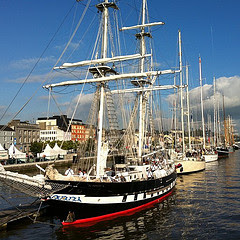Wexford proved to be a highly challenging area to survey, with numerous shallow sand banks forcing the Geo to operate in waters as shoal as 2m. With its fragile transducer hanging 0.6m below the waterline, this required great skill on the part of the skipper to safely manoeuvre the vessel through the shallows. To further complicate matters, the sand banks of Wexford harbour are highly mobile, and so their distribution no longer matched the existing nautical charts - hence the great need for an updated survey of the area.
Along with a requirement for very careful navigation, the survey crew also had to keep a careful watch on the tidal conditions. Due to its shallow nature, safe navigation between the shoals of Wexford harbour is extremely restricted by the tide - in many areas the Geo could only operate at high tide, with some of those areas drying out at lower water levels.

RV Geo on survey operations

RV Keary navigating off the coast
Another feature to note in Wexford harbour was the presence of a large seal colony. Great care was taken not to disturb the creatures during survey operations and so the Geo's surveyor also doubled-up as a marine mammal observer (MMO). In addition to reporting on the survey, the surveyor created an MMO report detailing sightings of the seals - a useful dataset in itself for marine biologists.

Survey area mapped by the RV Geo through Waterford Harbour. The blue end of the colour scale represents deeper water, with the shallow seabed represented as green, through yellow to red.

A large number of seals were observed on the edge of the sandbank in Wexford harbour
In addition to mapping the seabed with sonar, the crew of the RV Geo also collected many sound velocity profile (SVP) data.
The SVP data is necessary because the sonar systems measure the travel time of sound waves through the water. As water temperature and salinity differ from within and between survey areas, so too does the speed of sound. Therefore these effects must be corrected for in order to accurately map the seabed. The SVP data was acquired by lowering a probe down into the water column, measuring the temperature and salinity of the water and therefore providing the survey team with a record of the sound velocity in a given location. By conducting regular sound velocity casts in Wexford harbour, the team ensured that the final dataset would require minimal processing to correct for errors created by the changes in the water column. The advantage of acquiring this data is that the information gathered during the survey constitutes a unique dataset which can have additional use in the study of the local oceanography of the area.
Following the survey of Wexford Harbour, the RV Geo was transited by sea to Rosslare harbour. The RV Keary had commenced survey operations in Rosslare at this point, and both vessels conducted survey operations in the area. The RV Keary conducted the bulk of the survey work, with the Geo briefly carrying out bathymetric mapping.

Survey coverage in Rosslare harbour
Following survey operations in Rosslare, the RV Geo was taken out of the water and transported by land to Kilmore Quay, while the RV Keary remained in Rosslare to continue operations. A similar survey strategy was employed at Kilmore Quay, involving further mapping of the seabed using sonar and SVP data acquisition. A feature of interest off the coast there is St. Patrick's bridge, a ridge of raised seabed that juts southwards. Along with shallow areas near the harbour, this feature could only be crossed by RV Geo at high tide, and so like Wexford this survey also included tidally-restricted areas.

Survey coverage by RV Geo at Kilmore Quay


























 Distinctive layers of limestone off Horse Island, Co Clare.
Distinctive layers of limestone off Horse Island, Co Clare. 
 A 3D multibeam image of the S.S. Premier wreck showing the hull of the vessel lying in a general water depth of 21m.
A 3D multibeam image of the S.S. Premier wreck showing the hull of the vessel lying in a general water depth of 21m.  Multibeam echosounder image of the S.S. Premier in plan view.
Multibeam echosounder image of the S.S. Premier in plan view. 


 Pilots steer the ROV along the vent target as scientists observe the real-time video in the ROV control cabin.
Pilots steer the ROV along the vent target as scientists observe the real-time video in the ROV control cabin. Samples are collected from the depths of the ocean by the ROV manipulator arms and stored in compartments until the ROV is recovered.
Samples are collected from the depths of the ocean by the ROV manipulator arms and stored in compartments until the ROV is recovered.
 (Top) The rock dredge was deployed to collect rock samples from the seafloor. (Below) Scientist Maria Judge examines rock samples acquired from the Mid-Atlantic Ridge.
(Top) The rock dredge was deployed to collect rock samples from the seafloor. (Below) Scientist Maria Judge examines rock samples acquired from the Mid-Atlantic Ridge. The captain, crew and scientific team gather for a group photo after a highly successful survey.
The captain, crew and scientific team gather for a group photo after a highly successful survey.
 Holland 1 the Marine Institute's remotely operated vehicle will be used to explore the Mid-Atlantic Ridge and enhance our current knowledge of vent and seep systems.
Holland 1 the Marine Institute's remotely operated vehicle will be used to explore the Mid-Atlantic Ridge and enhance our current knowledge of vent and seep systems.

















